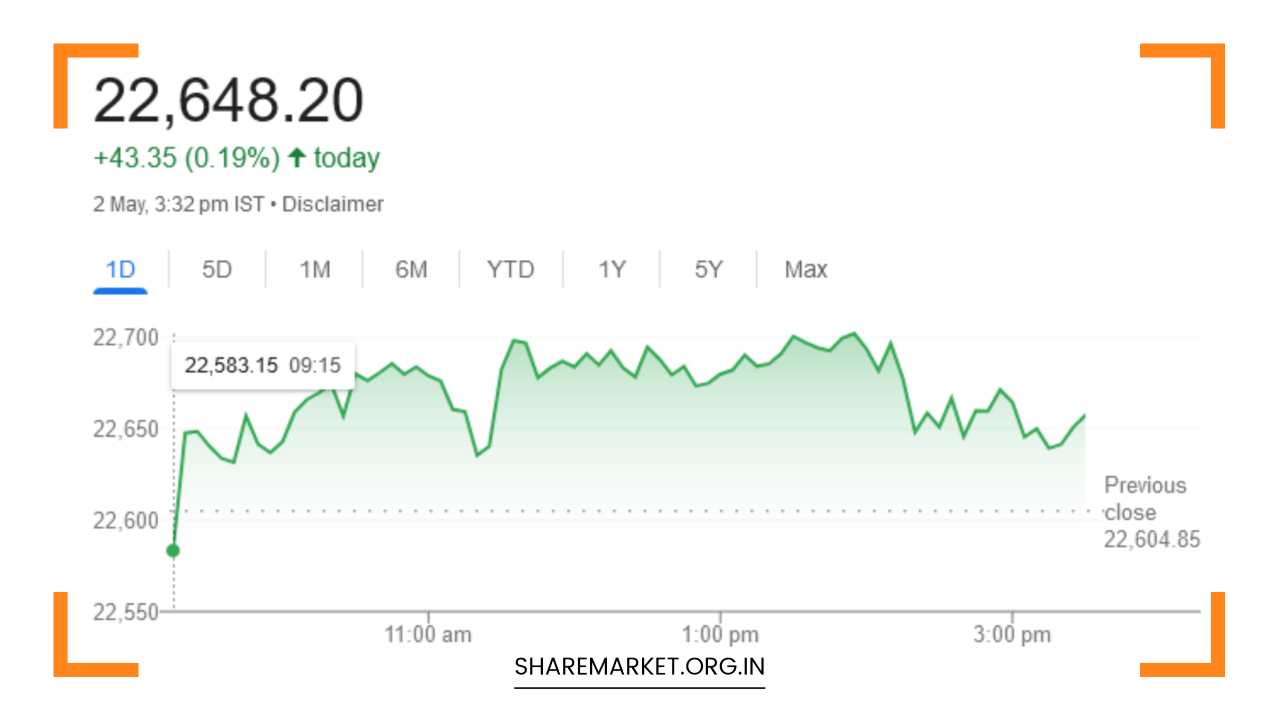Nifty Closed at 22,648; Tomorrow Nifty Prediction

Tomorrow Nifty Prediction
Indian Stock Market Prediction for May 3rd: A Comprehensive Analysis with Strategic Insights
Following a relatively subdued session on May 2nd, the Indian stock market is poised for a period of consolidation on May 3rd.
While this might imply a temporary lull in the recent upward momentum, it also presents valuable opportunities for investors who can navigate the potential breakout scenarios and underlying market dynamics.
Let’s delve deeper into the analyst predictions, key factors shaping the market trajectory, and strategic considerations for navigating this phase:
Nifty 50: Range-Bound Movement with Breakout Potential
Analysts anticipate Nifty 50 to trade within a defined range of 22,500 and 22,800, indicating a potential pause in the recent bullish trend. This range is characterized by:
- Immediate Support: 22,500, followed by the crucial 20-day exponential moving average (EMA) at 22,400. This level often acts as a psychological support for the index, offering a potential floor during any downward movements.
- Resistance: 22,775-22,800 (all-time high). A decisive break above this resistance could signal a bullish resurgence and pave the way for a move towards 23,000, potentially marking a new high for the index.
Therefore, while consolidation is expected, a breakout on either side is a possibility. Investors should closely monitor price action and technical indicators to identify potential trends and adjust their strategies accordingly.
Bank Nifty: Consolidation Within a Defined Range
Similar to Nifty 50, Bank Nifty is also likely to consolidate within a specific range:
- Support: 49000-48900. This zone provides a cushion against significant downside movements, offering a potential entry point for investors seeking value opportunities in the banking sector.
- Resistance: 49800-49850. Overcoming this resistance could indicate a bullish reversal for the banking sector, potentially leading to further upside potential.
The selling pressure witnessed on May 2nd in Bank Nifty suggests a cautious sentiment, but consolidation can also be a precursor to a stronger upward move, especially if positive news emerges within the sector.
Factors Influencing the Consolidation Phase:
- Digesting Fed’s Stance: The market is still absorbing the implications of the Fed’s decision to maintain interest rates, with the possibility of future hikes looming. This uncertainty can lead to a period of cautious trading, as investors weigh the potential impact on economic growth and corporate profitability.
- Technical Indicators: The lower bottom formation and bearish momentum indicator on Nifty’s hourly chart suggest a temporary decline in bullish momentum. This can contribute to sideways movement within the defined range, potentially creating a period of indecision before the next directional move.
- Global Cues: Broader market trends and international events, such as geopolitical tensions or economic data releases, can influence domestic market sentiment and potentially trigger breakouts from the consolidation phase. For instance, positive news from major economies or a dovish shift in global monetary policy could trigger a bullish breakout in the Indian market.
Strategic Considerations for Investors:
- Sectoral Diversification: While the broader market consolidates, focusing on specific sectors that are exhibiting relative strength can offer opportunities for targeted investments. For example, sectors like IT or pharmaceuticals might outperform during this phase due to their inherent resilience or positive industry trends.
- Fundamental Analysis: Beyond short-term market movements, focusing on company-specific fundamentals and long-term growth prospects remains crucial for making informed investment decisions. This involves analyzing a company’s financial health, competitive landscape, management quality, and future growth potential.
- Risk Management: Implementing effective risk management strategies is essential during periods of consolidation, as unexpected volatility can arise. This includes setting stop-loss orders, maintaining a diversified portfolio across different asset classes, and avoiding overexposure to any single stock or sector.
Beyond Consolidation: Potential Catalysts for Market Movement
While consolidation is the current expectation, certain factors could trigger a shift in market direction:
- Strong Corporate Earnings: If upcoming quarterly results from major companies surpass expectations, it could inject renewed bullish sentiment and propel the market beyond the consolidation range. Strong earnings growth can boost investor confidence and lead to a revaluation of stock prices.
- Positive Global Cues: Favorable developments in the global economy or positive news from international markets can also trigger a breakout, especially if they alleviate concerns about potential rate hikes or geopolitical tensions. For example, a resolution to a major global conflict or a significant improvement in global economic data could trigger a surge in investor optimism.
- Unforeseen Events: Geopolitical events, policy changes, or other unforeseen circumstances can significantly impact market sentiment and potentially lead to sharp movements in either direction. Investors should stay informed about such developments and be prepared to adjust their strategies accordingly.
Final Remarks: Navigating the Consolidation Phase with Strategic Clarity
The Indian stock market’s anticipated consolidation on May 3rd presents a period of cautious optimism. While sideways movement is expected, investors should remain vigilant for potential breakout opportunities on either side of the defined ranges.
By understanding the underlying factors influencing the market, employing sound risk management strategies, and focusing on long-term fundamentals, investors can navigate this phase effectively and potentially capitalize on future market movements.
Remember, staying informed, adaptable, and employing a strategic approach are key to success in the dynamic Indian stock market landscape.

















